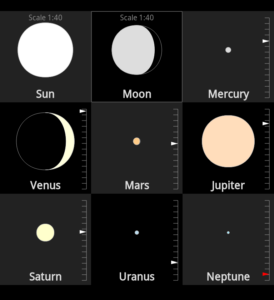The Sizes Comparison View shows a scaled image of the Planets, Sun and Moon, depicting their Apparent Diameters as viewed from Earth, taking into account their size, distance and solar phase on the selected date.

The vertical axis to the right of each object shows the Apparent Magnitude of the object. This shows how bright the object appears in the sky, accounting for its size, distance from the Sun, distance from the Earth, surface reflectivity characteristics and solar phase. The scale ranges from +9 (the bottom, dim end) to -5 (the top, brightest end).
Note:
- The 8 planets are shown to scale with each other, but the Sun and Moon are shown 40x smaller (since they are so much more massive in the sky).
- Only the Inferior planets (Venus and Mercury) and the Moon show a defined crescent since they are the only objects that pass between the Earth and the Sun. Mars exhibits a very slight crescent shape at certain points on its orbit, but the Outer planets are almost fully lit by the Sun at all times when viewed from Earth.
- A red brightness needle (eg as shown for Neptune) signifies a magnitude dimmer than +6, which is the rough limit for viewing an object with the human eye (under ideal conditions – dark night, clear sky, low light pollution, etc).
